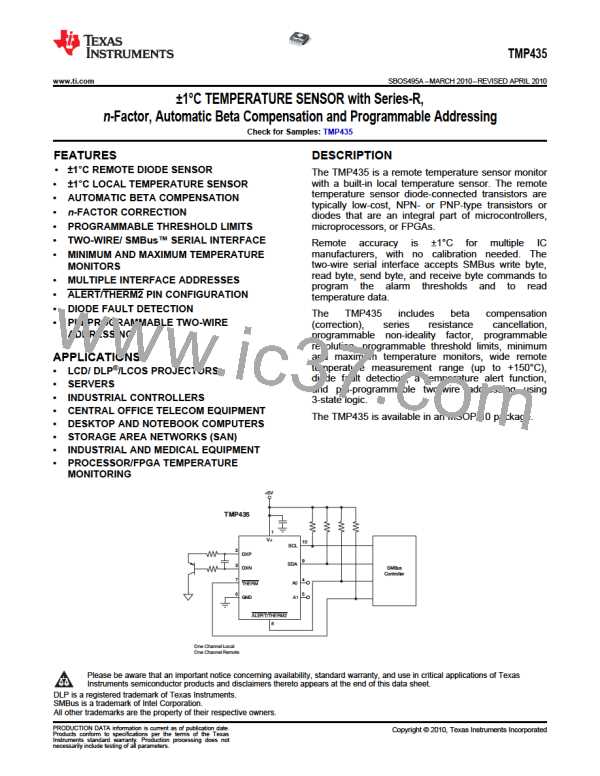TMP435
www.ti.com
SBOS495A –MARCH 2010–REVISED APRIL 2010
TIMING DIAGRAMS
Data Transfer: The number of data bytes transferred
between a START and a STOP condition is not
limited and is determined by the master device. The
receiver acknowledges the transfer of data.
The TMP435 is two-wire and SMBus-compatible.
Figure 15 to Figure 19 describe the various
operations on the TMP435. Bus definitions are given
below. Parameters for Figure 15 are defined in
Table 15.
Acknowledge: Each receiving device, when
addressed, is obliged to generate an Acknowledge
bit. A device that acknowledges must pull down the
SDA line during the Acknowledge clock pulse in such
a way that the SDA line is stable low during the high
period of the Acknowledge clock pulse. Setup and
hold times must be taken into account. On a master
receive, data transfer termination can be signaled by
the master generating a Not-Acknowledge on the last
byte that has been transmitted by the slave.
Bus Idle: Both SDA and SCL lines remain high.
Start Data Transfer: A change in the state of the
SDA line, from high to low, while the SCL line is high,
defines a START condition. Each data transfer is
initiated with a START condition.
Stop Data Transfer: A change in the state of the
SDA line from low to high while the SCL line is high
defines
a STOP condition. Each data transfer
terminates with a STOP or a repeated START
condition.
t(LOW)
tF
tR
t(HDSTA)
SCL
SDA
t(SUSTO)
t(HDSTA)
t(HIGH) t(SUSTA)
t(SUDAT)
t(HDDAT)
t(BUF)
P
S
S
P
Figure 15. Two-Wire Timing Diagram
Table 15. Timing Diagram Definitions for Figure 15
FAST MODE
HIGH-SPEED MODE
PARAMETER
MIN
MAX
MIN
MAX
UNITS
MHZ
ns
SCL Operating Frequency
f(SCL)
t(BUF)
0.001
0.4
0.001
3.4
Bus Free Time Between STOP
and START Condition
600
160
100
100
Hold time after repeated START
condition. After this period, the
first clock is generated.
t(HDSTA)
100
100
ns
ns
Repeated START Condition Setup
Time
t(SUSTA)
STOP Condition Setup Time
Data Hold Time
t(SUSTO)
t(HDDAT)
t(SUDAT)
t(LOW)
t(HIGH)
tF
100
0(1)
100
0(2)
10
ns
ns
ns
ns
ns
ns
ns
ns
Data Setup Time
100
1300
600
SCL Clock LOW Period
SCL Clock HIGH Period
Clock/Data Fall Time
Clock/Data Rise Time
for SCLK ≤ 100kHz
160
60
300
300
160
160
tR
1000
(1) For cases with fall time of SCL less than 20ns and/or the rise time or fall time of SDA less than 20ns, the hold time should be greater
than 20ns.
(2) For cases with fall time of SCL less than 10ns and/or the rise or fall time of SDA less than 10ns, the hold time should be greater than
10ns.
Copyright © 2010, Texas Instruments Incorporated
Submit Documentation Feedback
21
Product Folder Link(s): TMP435

 TI [ TEXAS INSTRUMENTS ]
TI [ TEXAS INSTRUMENTS ]